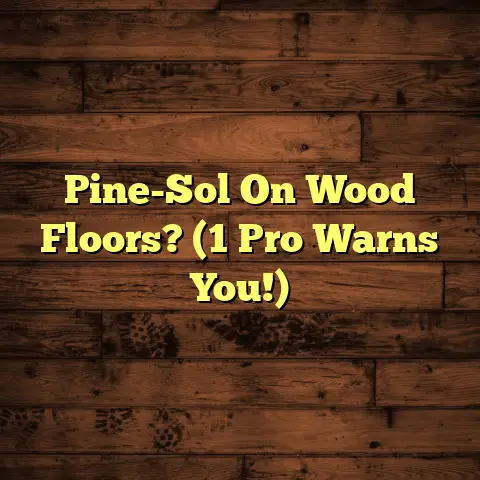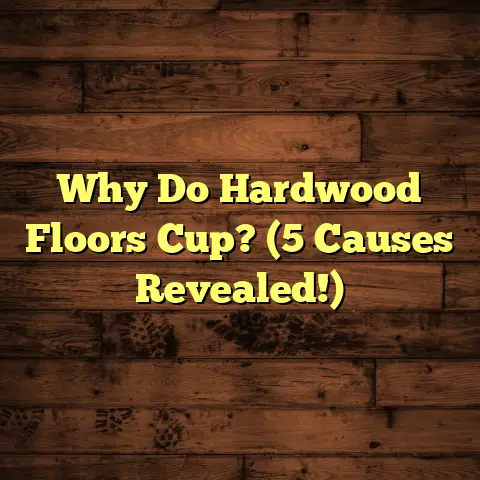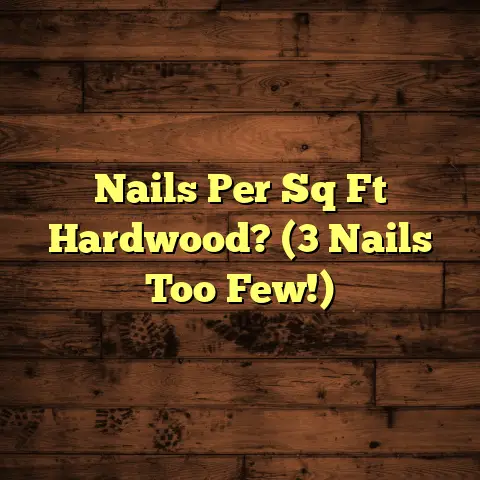Why Are Floors Squeaky? (Fix It Before It Fails!)
Picture this: it’s Thanksgiving. The whole family is gathered. Laughter fills the air as stories are shared and memories are made. But then, creak. Squeak. That darn squeaky floorboard chimes in disrupting the moment.
It’s like a tiny gremlin determined to ruin your family gathering. I’ve seen it countless times. Homeowners cringe as guests navigate the “squeaky spots,” a mix of embarrassment and frustration etched on their faces. Your home should be a sanctuary, a place of peace and happiness. Those squeaky floors? They chip away at that comfort.
They create tension where there should be joy. Believe me, I understand. I’ve been there, and I’ve helped countless homeowners silence those annoying squeaks for good. Let’s figure out why your floors are singing a less-than-melodious tune and how to fix it!
Section 1: Understanding the Causes of Squeaky Floors
So, what’s the deal with squeaky floors? Why do they suddenly decide to announce your every move?
Well, it’s usually not a sudden thing. It’s a gradual process, and there are several culprits at play. As a flooring contractor with years of experience, I’ve seen it all. Here are the most common reasons:
-
Natural Settling of the House: Think of your
house as a living, breathing thing. Over time,
it settles. The foundation shifts, and this
settling can create gaps between the flooringand the joists (those horizontal beams supporting
your floor). These gaps allow the wood to rub
against each other, causing that telltale squeak.
Imagine it like this: you have two pieces of wood
that are very close together. When you step onthem, they rub against each other, and that creates
the squeak. Settling is inevitable, especially
in newer homes. According to the American Society
of Civil Engineers, most homes will experience
some degree of settling within the first few years. -
Humidity and Temperature Changes: Wood is a
natural material, and it reacts to changes in
humidity and temperature. In humid conditions,
wood expands. In dry conditions, it contracts.
This expansion and contraction can loosen nails,create gaps, and cause boards to rub against each
other. I had a client in Florida whose hardwood
floors were practically silent in the winter but
squeaked like crazy in the summer. The high humidity
was the primary cause. A study by the ForestProducts Laboratory found that wood can expand and
contract by as much as 5% depending on the humidity
level. That might not sound like much, but it’s
enough to cause some serious squeaks. -
Wear and Tear: Let’s face it, floors take a
beating. Years of foot traffic, furniture moving,
and general wear and tear can loosen boards, bend
nails, and weaken the subfloor. Over time, this
wear and tear can lead to those annoying squeaks.I’ve seen floors where the nails are so old and
rusted that they barely hold the boards in place.
It’s like a domino effect. One loose nail leads
to another, and before you know it, your entire
floor is a symphony of squeaks. -
Improper Installation: This is a big one.
I cannot stress enough the importance of proper
floor installation. If the subfloor isn’t level,
if the boards aren’t properly secured, or if the
wrong type of fasteners are used, you’re settingyourself up for squeaks down the road. I’ve seen
DIY flooring projects gone wrong where the homeowner
used the wrong type of nails or didn’t leave enough
expansion space. The result? A squeaky, uneven
mess. A survey by the National Wood FlooringAssociation found that improper installation is a
leading cause of flooring problems, including squeaks.
So, do your research and hire a qualified installer!
Section 2: The Impact of Squeaky Floors
Okay, so squeaky floors are annoying. We get that. But what’s the real impact of living with them? It’s more than just a minor inconvenience. It can affect your quality of life in several ways:
-
Disruption of Daily Activities: Working from
home? Trying to sneak downstairs for a midnight
snack? Squeaky floors can turn these simple
activities into a frustrating ordeal. Every step
becomes a calculated maneuver to avoid setting offthe squeak alarm. I had a client who was a writer.
She told me that her squeaky floors were killing
her concentration. Every time someone walked by
her office, the squeaks would pull her out of her
train of thought. It was a constant source ofstress and distraction. According to a study by
the World Health Organization, noise pollution can
negatively impact cognitive performance and increase
stress levels. So, those squeaks aren’t just
annoying; they can actually affect your productivity. -
Potential Safety Hazards: While it might sound
dramatic, ignoring squeaky floors can lead to more
serious issues. A loose floorboard can become a
tripping hazard, especially for young children
or elderly individuals. And if the squeaking iscaused by a weakening subfloor, you could be facing
structural damage. I once inspected a home where
the squeaky floors were a sign of significant water
damage. The subfloor was rotting away, and the
floor was on the verge of collapsing. It was aserious safety hazard. According to the National
Safety Council, falls are a leading cause of injury
in the home. So, don’t ignore those squeaks! They
could be a sign of something more serious. -
Impact on Property Value: Let’s say you’re
trying to sell your home. Potential buyers will
be walking through, scrutinizing every detail.
And guess what? Squeaky floors are a major red
flag. They can give the impression that the homeis poorly maintained or has underlying structural
problems. I’ve seen buyers walk away from deals
because of squeaky floors. They just didn’t want
to deal with the hassle and expense of fixing them.
A survey by the National Association of Realtorsfound that home inspections are becoming increasingly
common, and buyers are more likely to request
repairs or renegotiate the price if problems are
found. So, if you’re planning to sell your home,
it’s worth fixing those squeaky floors. It could
increase your property value and make your home
more attractive to potential buyers.
Section 3: Identifying the Type of Flooring
Before you grab your toolbox and start tackling those squeaks, it’s important to identify the type of flooring you have. Different types of flooring require different approaches. Here’s a quick overview:
-
Hardwood: This is the classic. Hardwood floors
are beautiful, durable, and long-lasting. But
they’re also prone to squeaking, especially in
older homes. The squeaks are usually caused by
the wood rubbing against the joists or subfloor.With hardwood, you’ll often hear the noise coming
from the nails, the boards rubbing together, or
the wood rubbing against the subfloor. -
Laminate: Laminate flooring is a more affordable
alternative to hardwood. It’s made of a composite
material with a photographic layer that mimics
the look of wood. Laminate floors can also squeak,
especially if they’re not properly installed orif the subfloor is uneven. The hollow sound of
laminate can sometimes amplify the squeak. -
Tile: Tile floors are typically less prone to
squeaking than wood or laminate. However, if the
subfloor is uneven or if the grout is cracked,
tile floors can sometimes make noise. The sound
is often more of a clicking or popping than a squeak. -
Carpet: Carpet itself doesn’t usually squeak.
But the subfloor underneath the carpet can. If
you have squeaky floors under your carpet, you’ll
need to lift the carpet to address the underlying issue.
Identifying your flooring type is the first step. Once you know what you’re working with, you can choose the right tools and techniques to fix those annoying squeaks.
Section 4: DIY Fixes for Squeaky Floors
Alright, let’s get down to business. Here are some DIY fixes you can try to silence those squeaky floors. Remember to prioritize safety. Wear safety glasses and gloves when working with tools and materials.
-
Using Talcum Powder or Graphite: This is the
easiest and cheapest fix, and it often works for
minor squeaks. Talcum powder or graphite acts as
a lubricant, reducing friction between the floorboards.-
Instructions:
- Locate the squeaky area.
- Sprinkle talcum powder or graphite into the
gaps between the floorboards. - Use a soft brush or cloth to work the powder
into the cracks. - Wipe away any excess powder.
- Walk over the area to see if the squeak is gone.
Repeat if necessary.
-
Estimated Time: 5-10 minutes
- Tools Needed: Talcum powder or graphite,
soft brush or cloth
-
-
Screwing Down Loose Floorboards: This is a
more involved fix, but it’s often necessary for
more persistent squeaks. The goal is to secure
the loose floorboards to the joists or subfloor.-
Instructions:
- Locate the squeaky area.
- Find the nearest joist using a stud finder.
- Pre-drill a pilot hole through the floorboard
and into the joist. This will prevent the
wood from splitting. - Drive a screw through the floorboard and into
the joist. Use screws that are long enough
to penetrate the joist by at least 1 inch. - Counter sink the screw head so it’s flush
with the floor. - Fill the screw hole with wood filler and sand
it smooth. - Apply a finish that matches the surrounding
floor. - Walk over the area to see if the squeak is gone.
Repeat if necessary.
-
Estimated Time: 30-60 minutes per squeaky area
- Tools Needed: Stud finder, drill, drill bits,
screws, screwdriver, wood filler, sandpaper, finish
-
-
Using a Squeak-Ender Kit: These kits are designed
to fix squeaky floors from below, without having
to remove the flooring. They’re a good option if
you have access to the joists from a basement or crawl space.-
Instructions:
- Locate the squeaky area from above.
- Go to the basement or crawl space and find
the joist directly below the squeaky area. - Follow the instructions that come with the
Squeak-Ender kit. The kit typically includes
a metal bracket that attaches to the joist
and a screw that pushes up against the
subfloor. - Tighten the screw until the squeak is gone.
-
Estimated Time: 15-30 minutes per squeaky area
- Tools Needed: Squeak-Ender kit, drill or screwdriver
-
-
Installing a Shim: Shims are thin pieces of
wood that can be used to fill gaps between the
subfloor and the joists. They’re a good option
for fixing squeaks caused by uneven surfaces.-
Instructions:
- Locate the squeaky area from above.
- Go to the basement or crawl space and find
the joist directly below the squeaky area. - Identify any gaps between the joist and the
subfloor. - Insert a shim into the gap.
- Tap the shim in with a hammer until it’s snug.
- Break off any excess shim material.
-
Estimated Time: 10-20 minutes per squeaky area
- Tools Needed: Shims, hammer
-
Section 5: When to Call a Professional
While DIY fixes can be effective for minor squeaks, there are times when it’s best to call in a professional. Here are some red flags to watch out for:
-
Widespread Squeaking: If your entire floor is
squeaking, it could be a sign of a more serious
structural issue. It could indicate that the
subfloor is damaged or that the joists are sagging.
In these cases, it’s best to consult with a
professional to assess the situation and recommend
the appropriate repairs. I once had a client who
tried to fix widespread squeaking with DIY methods.
He ended up causing more damage and had to spend
even more money to fix the problem. -
Water Damage Signs: If you see signs of water
damage, such as stains, mold, or rot, it’s
important to call a professional immediately.
Water damage can weaken the subfloor and lead to
structural problems. A professional can identify
the source of the leak and repair any damage.
I’ve seen cases where homeowners ignored water
damage for too long, and the damage became so
extensive that they had to replace their entire floor. -
Uncertain About DIY Skills: Let’s be honest,
not everyone is comfortable tackling home repairs.
If you’re not confident in your DIY skills, it’s
perfectly okay to call a professional. There’s
no shame in admitting that you need help. It’s
better to hire a professional than to risk causing
more damage or injuring yourself. I always tell
my clients that it’s better to be safe than sorry.
Here are some testimonials from individuals who faced these dilemmas:
-
Sarah: “I had widespread squeaking in my
living room. I tried to fix it myself, but I
just made it worse. I finally called a professional,
and they discovered that the subfloor was damaged.
They replaced the subfloor, and now my floors are
silent.” -
John: “I noticed water stains on my ceiling.
I called a professional, and they found a leak
in my bathroom. They repaired the leak and replaced
the damaged flooring. I’m so glad I didn’t try
to fix it myself. I could have made the problem
much worse.” -
Mary: “I’m not very handy, so I decided to
call a professional to fix my squeaky floors.
They did a great job, and I didn’t have to worry
about messing anything up.”
(Conclusion)
Squeaky floors are more than just an annoyance. They can disrupt your daily life, create safety hazards, and even affect your property value. That’s why it’s so important to address them promptly. Whether you choose to try a DIY fix or call a professional, taking action is the key.
Remember that family gathering from the beginning? Imagine that same scene, but this time, the floors are silent. The laughter fills the air, and the memories are made without any annoying interruptions. That’s the power of fixing those squeaky floors.
So, don’t let those squeaks steal your joy. Take control of your home and create a peaceful, safe, and comfortable living environment. With timely attention and care, your home can continue to be a place of comfort, joy, and cherished memories. And if you need help, don’t hesitate to reach out to a professional. We’re here to help you silence those squeaks for good!





